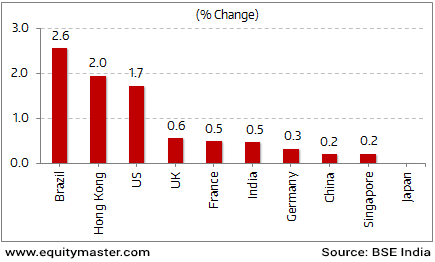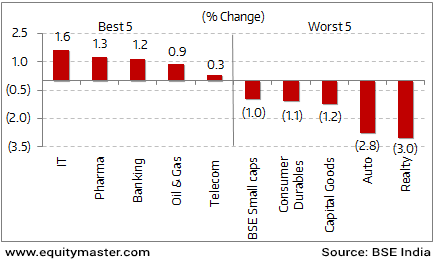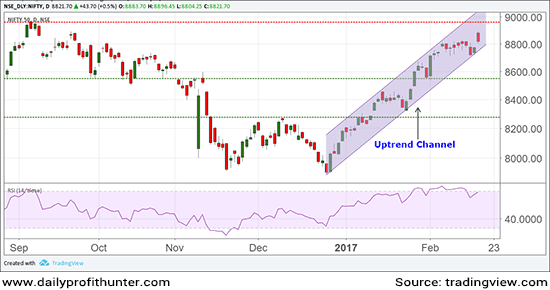- Home
- Todays Market
- Indian Stock Market News February 18, 2017
Global Stock Markets Continue Positive Momentum Sat, 18 Feb RoundUp
Most of the global financial markets ended the week on a positive note. The Brazilian index registered a 2.6% growth over the week, making it the top gainer. Indices in Hong Kong (up 1.9%) were among the top gainers for the week as positive cues from the US stock markets lifted the Asian stock markets. European financial markets closed on a flattish note. A host of strong economic data across various countries and hopes that US President Donald Trump would take measures that will boost US economic growth helped to support global indices.
US financial Markets (up 1.7%) continue to see new highs, as Donald Trump reinforced news regarding a major tax reform coming soon in the US. Trump is looking forward to lower the tax burden on corporates. The US stock markets have rallied by almost 8% since Trump's victory in the elections. Meanwhile, Federal Reserve Chairwoman Janet Yellen appeared to reinforce the market's optimism when she testified in front of the Senate Banking Committee that investors are expecting a more growth-supportive fiscal policy and a boost corporate earnings, increase infrastructure spending. Janet Yellen also said the U.S. central bank could raise interest rates as soon as next month.
Among developed economies, all European indices closed on a slightly weaker note in contrast to the rally earlier in the week. The UK indices closed the week up by 0.6%, while the German and French indices ended the week on a flattish note with gains of 0.3% and 0.5% respectively.
Back home, the BSE-Sensex ended in green and was up 0.5%. The week started on a positive note with some dull streaks over the week amid quarterly result updates announced by major companies. Favorable results from most companies kept the stock markets buoyant. On the other end Tata Motors reported a 96% fall in net profit in its quarterly result update, leading to a steep fall in its share price. Tata motors stock fell by 11% over the week.
Meanwhile, HDFC Bank's share price rallied handsomely over RBI's decision to allow FII investments in the bank. However, the stock pared much of its gains as the RBI had to reinstate the restriction after the FII investments reached the stipulated cap. HDFC bank's stocks rallied over 5% in the week.
Key World Markets During the Week

On the sectoral indices front, IT sector and pharma sector stocks led the gainers this week. On the other hand, stocks from realty sector, auto sector, and capital goods sector witnessed maximum selling pressure.
BSE Indices During the Week

Now let us discuss some key economic and industry developments during the week gone by
In the news from domestic stock markets, Reserve Bank of India (RBI) Governor Urjit Patel has stated that India's growth will bounce back after a sharp slowdown triggered by government's notebandi. The governor said that the benefits of the notebandi drive will take time to fully play out and need more work to ensure they're lasting. As per him, remonetisation has happened at a fast pace and that was part of the plan. However, if one has to look at the data, re-monetisation is where things really fell apart. According to an article in the Mint, as of January 2017, the total currency in circulation is 57% of what it was before notebandi. In fact, as per RBI data, the cash with public is 40% less than what it was one year ago. So going by the ground realities, the economy is still facing troubles for the notebandi drive initiated by the government. The government will continue with its lies to tell us that all is well on the notebandi front, but that doesn't make the situation any better for the common man.
According to a leading financial daily, the India's gross domestic product (GDP) is likely to grow by 7.4% year-on-year in FY18. This is on the upper end of the 6.75 to 7.5% band estimated in the Economic Survey. The rating agency India Ratings and Research (Ind-Ra) however revised down GDP growth forecast for FY17 to 6.8% from 7.9% estimated earlier. This downgrade is even lower than Central Statistical Organisation's advanced estimate of 7.1%. Ind-Ra has said that the gross value added (GVA) of the three production sectors including agriculture, industry and services would grow at 3%, 6.1% and 9.1% year-on-year respectively in 2017-18, backed by consumption demand and government spending. However, private final consumption expenditure is expected to grow at 8.9%, the government final consumption expenditure is expected to clock 9% growth in the next financial year. For current account deficit it said that it is likely to come at 1% of GDP in FY18 as against 0.9%.
Data released in the week showed the WPI rose to a two-and-a-half-year high of 5.2% in January. This compared with 3.39% in December. The rise was seen on the back of costlier fuel and adverse base effect. Furthermore, core wholesale inflation (which excludes food and fuel items) firmed up to a 28-month high of 2.67%. The above WPI inflation data depicts the widening divergence with the consumer price index (CPI) inflation. CPI inflation (retail inflation) fell to a five-year low at 3.17% in January. The decline was led by a marked fall in food inflation. While this came as a welcome breather, the same is expected to rise as the cash crunch led by demonetisation turns normal. So when consumer spending normalizes, we should all be on our guard for rising inflation.
As per data released by the Central Statistics Office (CSO), India's industrial production contracted by 0.4% in December. The contraction has been directly attributed to the demonetisation of high value currencies in November 2016. The general Index of Industrial Production (IIP), for the month of December 2016, stands at 183.5, which is 0.4% lower as compared to the level in the month of December 2015. The index contracted a month after recording a 13-month high growth due to a positive base effect. The data showed while mining and electricity output grew 5.2% and 6.3% respectively in December, manufacturing contracted by 2% during the month. Capital goods, which is an indicator for investment demand in the economy contracted 3% in December. However, the impact of demonetisation was clearly visible from the 5% contraction in production of consumer non-durables and 10.3% fall in production of durables, signaling that consumption demand in both rural and urban demand has been impacted.
Moving on to the news from bank stocks. As per an article in a leading financial daily, the Union Cabinet has approved the merger of five of State Bank of India's (SBI) subsidiaries, including State Bank of Bikaner and Jaipur (SBBJ), State Bank of Hyderabad (SBH), State Bank of Mysore (SBM), State Bank of Patiala (SBP), and State Bank of Travancore (SBT) with the SBI. Reportedly, SBI will offer 28 of its shares (face value of Rs 1 each) for every 10 shares (Rs 10 each) held of SBBJ. It will offer 22 of its shares each for every 10 shares held of SBM and SBT. The other two are wholly owned subsidiaries of SBI. With the merger of all the five associates, SBI is expected to become a global-sized bank with an asset base of Rs 37 trillion, 22,500 branches and 58,000 ATMs. It will have over 50 crore customers, the reports noted. According to Finance Minister Arun Jaitley, the merger would lead to a saving of more than Rs 10 billion in the first year through operational efficiency and reduced cost of funds. Further, this will minimise vulnerability to any geographic concentration risks faced by associate banks. This merger is an important step towards strengthening the banking sector through consolidation of public sector banks. One must note that the merger proposal was announced in May 2016 and was scheduled for March 2017. The merger of SBI's subsidiaries is the first and probably the easiest phase in the government's consolidation process.
India Ratings and Research (Ind-Ra) in its latest report has maintained stable outlook on large public sector banks and private sector banks supported by high levels of capital. At the same time, it retained its negative outlook on mid-sized and smaller state-run banks due to limited access to capital and large non-performing assets. It said that while the large public sector banks with better access to capital and private sector banks with their robust capitalization will navigate another year of low growth and high credit costs with a stable outlook, mid-sized and smaller state-run banks will find it increasingly difficult to grow given increasing capital requirements and large funding gaps impeding their ability to compete on spreads. The rating agency however said that long term ratings of all public sector banks remain resilient on expectations of continued government support. The report also said that Indian banks will need Rs 910 billion in Tier-I capital until March 2019 to grow at a bare minimum pace of 8 to 9% compound annual growth rate including a residual Rs 200 billion from the government's bank recapitalization program 'Indradhanush'.
Movers and Shakers During the Week
| Company | 10-Feb-17 | 17-Feb-17 | Change | 52-wk High/Low |
|---|---|---|---|---|
| Top Gainers During the Week (BSE Group A) | ||||
| Cadila Healthcare | 365.95 | 448.6 | 22.6% | 440/305 |
| Jaiprakash Asso. | 14.06 | 15.29 | 8.7% | 15/5 |
| Grasim Ind | 971.95 | 1,042.5 | 7.3% | 1,070/648 |
| Petronet LNG | 377.15 | 401.25 | 6.4% | 411/230 |
| SVJN | 33.8 | 35.95 | 6.4% | 36/26 |
| Top Losers During the Week (BSE Group A) | ||||
| Tata Motors | 512.8 | 450.75 | -12.1% | 599/290 |
| Unitech | 6.73 | 5.98 | -11.1% | 9/4 |
| Bank of Baroda | 184.4 | 166.00 | -10.0% | 192/126 |
| Corporation Bank | 51.30 | 46.40 | -9.6% | 57/31 |
| Crompton Greaves | 72.3 | 65.50 | -9.4% | 160/41 |
Some of the key corporate developments in the week gone by
HDFC Bank was in focus at the end of the week after it was reported that Reserve Bank of India removed restrictions placed on foreign institutional investors on the purchase of shares of the lender with immediate effect. RBI in notification stated that the aggregate foreign shareholding through American Depository Receipts (ADR)/Global Depository Receipts (GDR)/ Foreign institutional Investors (FIIs)/Foreign Portfolio Investors (FPIs)/ Foreign Direct Investment (FDI)/Non-Resident Indians (NRIs)/ Persons of Indian Origin (PIOs) in M/s HDFC Bank Ltd. have gone below the prescribed limit stipulated under the extant FDI Policy. Hence the restrictions placed on the purchase of shares of the above company are withdrawn with immediate effect. Foreign ownership in private banks is restricted to 74%, a limit which is periodically reviewed by the Reserve Bank. However, HDFC Bank pared gains after the private sector lender crossed overall limit of 74% of its paid-up capital.
Bharat Forge's subsidiary - Kalyani Strategic Systems (KSSL), the defense arm of Kalyani Group and Israel Aerospace Industries (IAI) have signed a Memorandum of Understanding (MoU) to incorporate a Joint Venture Company (JVC) in India. As part of the MoU, IAI and KSSL are aiming to expand their presence in the Indian defense market and to Build, Market and Manufacture specific Air Defense Systems and Ground to Ground & Ground to Sea Munitions. The MoU is the first step of a process to establish a JVC between the two companies. The JVC will integrate strategic state-of-the-art defense systems for the Indian ministry of defense in accordance with the Indian Government's 'Make in India' policy.
In news from stocks in the IT sector. TCS shares were in focus during the week as the company informed exchanges that its board would consider a proposal for buyback of equity shares of the company at its meeting to be held on February 20, 2017. The buyback, if approved in the board meeting, would be the company's first since its listing in 2004. The news came at a time when Indian IT companies are under pressure to address shareholders' concerns. Investors have been expecting Indian IT firms to offer buybacks or dividends for a long time as the companies sit over billions in cash. TCS has Rs 431 billion cash on its books at the end of the December quarter, which is nearly 9% of its market capitalisation. TCS can do buyback of maximum of Rs 209 billion or 25% of its net worth. Indian IT companies are facing multiple headwinds in recent times, including concerns over corporate governance issues in Infosys. Regulatory changes over visa processes in USA - which remains a major market for IT firms - have added to the woes.
Moving on to news from stocks in pharma sector. Pharma stocks finished week on a positive note. Sun Pharmaceuticals reported that the company's subsidiary received approval for Tobramycin from the European Medicines Agency. The approval for the product was received by company's wholly owned subsidiary firm from the European Medicines Agency. The company and its subsidiaries continue to file multiple products across multiple countries on an on-going basis. Sun Pharma posted a net profit decline of 5% to Rs 14.71 billion in the third quarter ended December as compared to Rs 15.44 billion in the same period previous year. In another development, Lupin announced that the company received final US Food and Drug Administration (USFDA) approval for ANDA Moxifloxacin Hydrochloride Tablets, 400 mg, generic of Avlox Tablets of Bayer Healthcare Pharmaceuticals, Inc. The company has recently received final approval for its Triamcinolone Acetonide Cream USP, 0.025%, 0.1% and 0.5% from the USFDA to market a generic equivalent of Mylan Pharmaceuticals Inc.'s.
The auto sector finished down by over 2.8% this week. The downside was led by the shares of Tata Motors plummeting. Tata Motors reported a 96.2% decline in consolidated net profit to Rs 1.1 billion for the December quarter, dragged down by losses in domestic operations and lower profit of its British arm Jaguar Land Rover (JLR). It had posted net profit of Rs 29.5 billion in the same quarter of last fiscal. The company's consolidated sales during the October-December quarter were down 2.2% at Rs 678.6 billion against Rs. 694 billion in the year-ago period. On a standalone basis, Tata Motors' losses after tax widened to Rs. 10.5 billion in the third quarter of 2016-17 from Rs 1.4 billion a year ago. Domestic performance remained muted as commercial volumes hit by demonetisation. Domestic total volume growth slowed down to 5.3% YoY at 1.15 lakh units, commercial vehicle volumes down 3.3% at 75,705 units and passenger vehicle volumes up 27.2% at 39,874 units.
Moving on to the PSU sector, the government plans to divest up to 10% in Coal India by August. It is likely to help the government raise around Rs 200 billion and reduce its stake to 69%. Last year, Coal India offered to buy-back 1.7% (108.9 million shares) of its fully paid-up equity shares at Rs 335 per share totaling Rs 36.5 billion. After the buy-back, the government's holding in Coal India increased marginally to 79.78% from 79.68%. This move will also allow Coal India to conform to holding norms in which a public listed company needs to have at least 25% shares listed on stock exchanges. The timing of the divestment will be crucial because the company has not been able to fulfill its targets. Revenues and profits are likely to be less than anticipated as price realization from an e-auction has been falling due to reduced demand.
And here's an update from our friends at Daily Profit Hunter...
The Nifty 50 Index traded volatile for the week. It was flat at the start of the week but slipped by 67 points on Wednesday. On the next day, the index recovered the losses after finding support from the uptrend channel line. Finally, on Friday, the index opened 106 points gap up, but the bulls couldn't hold the rally and the index immediately slipped to end the session only 43 points up. The Nifty ended its weekly session with marginal gains of 0.31%. You can read the detailed market update here...
Nifty 50 Index Ends in the Green

For information on how to pick stocks that have the potential to deliver big returns, download our special report now!
Read the latest Market Commentary


Equitymaster requests your view! Post a comment on "Global Stock Markets Continue Positive Momentum". Click here!
Comments are moderated by Equitymaster, in accordance with the Terms of Use, and may not appear
on this article until they have been reviewed and deemed appropriate for posting.
In the meantime, you may want to share this article with your friends!